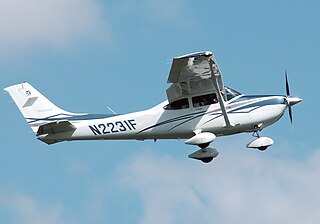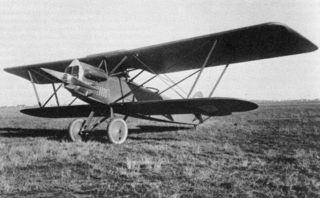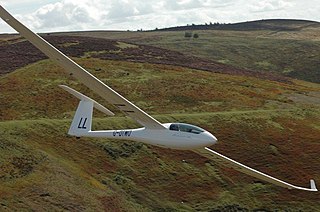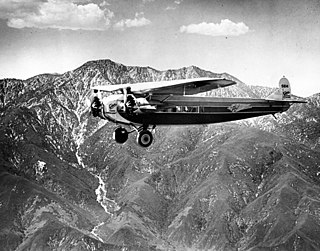Related Research Articles

The Blohm & Voss BV 138Seedrache, but nicknamed Der Fliegende Holzschuh was a World War II German trimotor flying boat that served as the Luftwaffe's main seaborne long-range maritime patrol and naval reconnaissance aircraft.

The Cessna 182 Skylane is an American four-seat, single-engined light airplane, built by Cessna of Wichita, Kansas. It has the option of adding two child seats, installed in the baggage area.

The Aero A.30 was a biplane light bomber and reconnaissance aircraft built in Czechoslovakia in the late 1920s. It originated as an attempt by Aero to improve the performance of the Aero A.11, but soon evolved into quite a different aircraft, larger and more powerful than its predecessor. The aircraft is readily distinguished from other related types by the difference in spans between its wings – the upper set being of much greater span than the lower.

The Aero A.34 Kos was a small sports and touring biplane built in Czechoslovakia in the 1930s.

The Grumman American AA-5 series is a family of American all-metal, four-seat, light aircraft used for touring and training. The line includes the original American Aviation AA-5 Traveler, the Grumman American AA-5 Traveler, AA-5A Cheetah, and AA-5B Tiger, the Gulfstream American AA-5A Cheetah and AA-5B Tiger, the American General AG-5B Tiger, and the Tiger Aircraft AG-5B Tiger.

The Cessna 188 is a family of light agricultural aircraft produced between 1966 and 1983 by the Cessna Aircraft Company.

The Schempp-Hirth Discus-2 is a Standard Class sailplane produced by Schempp-Hirth since 1998. It replaced the highly successful Schempp-Hirth Discus.

The Curtiss SO3C Seamew was developed by the Curtiss-Wright Corporation as a replacement for the SOC Seagull as the United States Navy's standard floatplane scout. Curtiss named the SO3C the Seamew but in 1941 the US Navy began calling it by the name Seagull, the same name as the aircraft it replaced, causing some confusion. The British Royal Navy kept the Curtiss name, (Seamew), for the SO3Cs that they ordered. One of the US Navy's main design requirements was that the SOC Seagull's replacement had to be able to operate both from ocean vessels with a single center float and from land bases with the float replaced by a wheeled landing gear.

The 7.5 cm KwK 40(7.5 cm Kampfwagenkanone 40) was a German 75 mm Second World War era vehicle-mounted gun, used as the primary armament of the German Panzer IV (F2 models onwards) medium tank and the Sturmgeschütz III (F models onwards) and Sturmgeschütz IV tank destroyers/assault guns.

The Piper PA-12 Super Cruiser is an American three-seat, high wing, single-engine conventional landing gear-equipped light aircraft that was produced by Piper Aircraft between 1946-48. The PA-12 was an upgraded and redesignated Piper J-5.

The Fokker F-10 was an enlarged development of the Fokker F.VII airliner, built in the late 1920s by the Fokker Aircraft Corporation of America. It carried 12 passengers, four more than the F.VII, and had a larger wing and more powerful engines.
The PZL M-24 Dromader Super is a single engine agricultural aircraft, developed in the 1980s by the WSK-Mielec from the PZL-Mielec M-18 Dromader. It remained a prototype.

The Bell HSL was an American 1950s anti-submarine warfare (ASW) helicopter built by the Bell Helicopter company, the only tandem rotor type designed by Bell.

The Keystone LB-6 and LB-7 were 1920s American light bombers, built by the Keystone Aircraft company for the United States Army Air Corps, called Panther by the company, but adoption of the name was rejected by the U.S. Army.

The Grigorovich M-11 was a Russian single-seat fighter flying boat designed by Dmitry Pavlovich Grigorovich and built by Shchetinin

The Potez 32 and its military version the Potez 33 was a single-engine French monoplane transport built by Potez and based on the Potez 29 biplane.

The Potez 36 was a French two-seat touring or sport monoplane designed and built by Potez. The Potez 36 was a high-wing braced monoplane with a conventional landing gear. It had an enclosed cabin with side-by-side seating for a pilot and passenger. The design had some unusual features like folding wings to make it easier to store or to tow behind a motor car. Some of the aircraft had Potez-designed leading-edge slats. The aircraft was popular with both French private owners and flying clubs with a small number being used by the French Air Force during the 1930s as liaison aircraft.
The Morane-Saulnier MS.560 was a French civil aerobatic monoplane designed and built by Morane-Saulnier.

The Mohawk M1C was a 1920s American two or three-seat low-wing monoplane designed and built by Mohawk Aero Corporation of Minneapolis, Minnesota. One M1C was evaluated by the United States Army Air Corps in 1930 as the YPT-7 Pinto for use as a primary trainer.

The Caudron C.161 was a lightweight French two-seat biplane designed by Caudron for sport or flight training use. A conventional biplane with a square fuselage powered by a 65 hp (48 kW) Salmson radial engine. It had two cockpits in tandem with dual controls in both, when not used as a trainer the controls could be removed from the rear cockpit. A variant, the C.168, with a more powerful 70 hp (52 kW) Anzani radial engine was also available.
References
This article contains material that originally came from the web article Unmanned Aerial Vehicles by Greg Goebel, which exists in the Public Domain.
| This article on an aircraft of the 1990s is a stub. You can help Wikipedia by expanding it. |